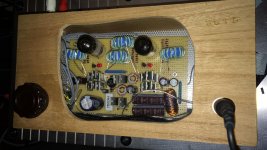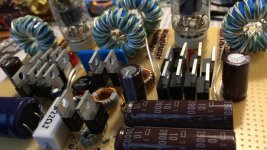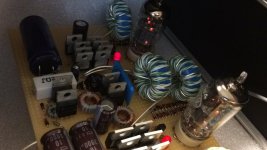Same here, combined with an OLED screen and of course watching all those critical parameters needed for reliable operation (and intervening if needed with a quick shutdown). I also think about a reset button and a tube lifecycle tracker (counting powered-on hours and saving last value for next time when the device is switched on again so I can see tube usage and decide when to swap them) - because going by ear can be quite tricky, the brain accomodates to the very slow degradation of sound and at the end we might still think the tubes are good - while after swapping them to new a big surprise comes with the recognition what we've listened for days recently.
Last edited:
I'm gonna try and use it to display cathode currents, bias voltages etc. Even to control the bias module maybe. At least to use it for remote control volume and input switching.
I was going to do something similar with a tiny oled display. I can post the beginning code to read from the ADC pins and display it.
In the world of microcontrollers you'll blink a LED sooner than printing 'hello world' on any attached screen. 😀 (Actually, these are equivalents of eachother lol). 😉
Couldn't attach to the previous post so here it is.
I’ll second this one, I’ve used an ECC99, for the WCF, but I’m sure the 6N1P does a nice job.
Ladies (if any) 😀 and Gentlemen,
I'm still using my little toy with great satisfaction, had to fiddle around with some hum in the AC heating but solved it finally.
Fun fact: tubes make even a mediocre Class-D stellar
After some months of listening now via headphones exclusively (hey, it's a hp amp or what 🙄 ) today morning I though how about plugging my Genius 2.1 set's jack into this HP amp, instead of the PC.
And I'm like WTF 😀 Woooo-hoooo!!!! 😱
They sound like if I've swapped the whole thing. Of course on the same EQ'd settings like before, to correct some of the flaws such little toys have usually. But I've never ever tought driving the signal through the tube hp amp would make such an insane difference on such a cheapo toy for kids. Omg. 😀😀😀 This is fabulous.
I think I'm going to make another Aikido set, acting like a tube preamp with fixed 1x amplification (or 2x max to allow some room for gain control). And then match that with the Hypex. Hoooly ****. That's the natural sound of Class-D: it just simply reflects what's fed in and if that's good-sweet, it will remain good-sweet afterwards too.
How nice
(Pot on the hp amp is at about 1/4 level, on the Genius 2.1 at about 1/4 too, PC Foobar volume 100%, PC OS Volume 90%).
I'm still using my little toy with great satisfaction, had to fiddle around with some hum in the AC heating but solved it finally.
Fun fact: tubes make even a mediocre Class-D stellar
After some months of listening now via headphones exclusively (hey, it's a hp amp or what 🙄 ) today morning I though how about plugging my Genius 2.1 set's jack into this HP amp, instead of the PC.
And I'm like WTF 😀 Woooo-hoooo!!!! 😱

They sound like if I've swapped the whole thing. Of course on the same EQ'd settings like before, to correct some of the flaws such little toys have usually. But I've never ever tought driving the signal through the tube hp amp would make such an insane difference on such a cheapo toy for kids. Omg. 😀😀😀 This is fabulous.
I think I'm going to make another Aikido set, acting like a tube preamp with fixed 1x amplification (or 2x max to allow some room for gain control). And then match that with the Hypex. Hoooly ****. That's the natural sound of Class-D: it just simply reflects what's fed in and if that's good-sweet, it will remain good-sweet afterwards too.
How nice

(Pot on the hp amp is at about 1/4 level, on the Genius 2.1 at about 1/4 too, PC Foobar volume 100%, PC OS Volume 90%).
Many headphones have such high sensitivity that they don't need any extra amplification with a standard source like a CD player.
I successfully tried a simple setup with Atlas AT-10 600 -Ohm volume control autoformer. In CD player, the electrolytic output capacitor was shorted, and series output resistor replaced with RF choke. It worked straight into HD-650 phones (300 Ohm), or through UTC A-23 transformer into 30 Ohm phones.
I successfully tried a simple setup with Atlas AT-10 600 -Ohm volume control autoformer. In CD player, the electrolytic output capacitor was shorted, and series output resistor replaced with RF choke. It worked straight into HD-650 phones (300 Ohm), or through UTC A-23 transformer into 30 Ohm phones.
Cool, I might try this trick somewhen. Less components in the signal path at least. Interesting idea. Thanks.
Hi kodabmx,I use this. It will swing 42mA. 28R is close enough to 32R that this circuit will drive it. Bonus: No OPT!
The tubes aren't JJ, but you can use ECC99 instead of 6N6P... 6N6P is cheaper though 🙂
I'm enjoying this very exact schematics since I asked for help here and I still can't thank you enough for all the help and this circuit schematics.
Now I intend to do some changes regarding my gear:
- use the 26 Ohms closed-back MH-751 with a separate DAP while on the move
- buy a 300 Ohms open-back Sennheiser HD800S and drive it via it's own balanced cable
What do I exactly need to modify in order to go balanced with the Sennheiser with the least modification to create the normal + opposite signals for the XLR outs ? (And remaining push-pull with good PSU ripple rejection).
I'm going to upgrade PSU part for an even more low-noise variant while moving the whole stuff into a new, larger chassis. This is the main trigger for the changes, besides getting some more juice with a higher-impedance headphone.
The only "easy" way would be to use transformers to go from SE to BAL... Or build a second one and use a phase splitter to drive them both...
The Triad TY-250P might be good enough, but you probably want Jensen or Hammond or Lundhal...
The Triad TY-250P might be good enough, but you probably want Jensen or Hammond or Lundhal...
Thank you. Another thing is just popping up in my mind: a tube splitter stage wouldn't be that difficult to make, but considering that the whole normal + inverted signal paths are (would be) amplified with this fully tube circuitry, I assume there'll be some mismatch between the two signals and I think the deviation might be too big (still inaudible) to create an effective balanced setup when they finally joined on the other side (whichever way).
Tubes are matched but still.. tubes.. not solid state. They inevitably have a little bigger spread between specs.
I know it could be elaborated by some circuit-based clever tricks..
So I'm considering if that's a good idea at all or better stay as it is now, SE, and be good with it. The sound is still amazing, soooo micro-detailing, I love it.
Tubes are matched but still.. tubes.. not solid state. They inevitably have a little bigger spread between specs.
I know it could be elaborated by some circuit-based clever tricks..
So I'm considering if that's a good idea at all or better stay as it is now, SE, and be good with it. The sound is still amazing, soooo micro-detailing, I love it.
Let me offer another perspective: the "normal" and the "inverted" signals are an arbitrary convention; both contain the exact same information, and each can become the other by swapping speaker connections. There is no particularly noble polarity, even if one were to be defined with a particular recording.
Also, surprisingly, electron valves (even in these degraded modern times) are built to much, much higher tolerance (20% is often guaranteed) than transistors or FETs, which must usually be batch sorted into color coded 100% groups. Modern tolerances come from sorting, not manufacture. And modern circuit design is focused on tolerance of tolerance.
All good fortune,
Chris
Also, surprisingly, electron valves (even in these degraded modern times) are built to much, much higher tolerance (20% is often guaranteed) than transistors or FETs, which must usually be batch sorted into color coded 100% groups. Modern tolerances come from sorting, not manufacture. And modern circuit design is focused on tolerance of tolerance.
All good fortune,
Chris
Also keep in mind, every push pull tube amp works in a balanced configuration.
Personally, I see no reason whatsoever to use balanced for headphones. Single ended works perfectly fine to me 🙂
Personally, I see no reason whatsoever to use balanced for headphones. Single ended works perfectly fine to me 🙂
Hi 🙂I use this. It will swing 42mA. 28R is close enough to 32R that this circuit will drive it. Bonus: No OPT!
The tubes aren't JJ, but you can use ECC99 instead of 6N6P... 6N6P is cheaper though 🙂
Still using this headphone amp of yours (the very exact schematics, 6N1P-6N6P) and I'm so grateful for this simple design.
Just swapped my 26 Ohms headphone to a Beyerdynamic DT 770 PRO 250 Ohms.
DC voltage is 300V istead of 280 due to some oversizing of the transformer load and it doesn't drop that much as I expected, otherwise the thing is working since more than a year flawlessly without any error. Oh and swapped diode bridge from 1N4007-s to Vishay Ultrafast Hexfreds, not sure if it brings any advantage but they're already in. (With 2x 470uF in parallel after that, per side).
Now what I notice with the 250 Ohms DT 770 PRO is that hum is higher, it appeared again. Heating was AC and I managed to route it properly so that it doesn't pollute anymore, then I switched it to DC heating to fully eliminate any residues from the heating side. Running at 6.1 volts now, specs say 5.7-7 so I'm good with that (intentionally).
So it might be only the anode voltage side to let in some hum, already played around with RCA inputs, ground (star, bus), whatever... changed tubes too.. it simply doesn't disappear fully. Can't think of anything else than anode side. When I switch off the amp and it still plays for more than 10 seconds easily, at the very moment the power relay releases, hum is gone.
Now I'm considering a cascade LC-LC filtering with 2x 2H chokes (or 1 LC with 10H choke would also be sufficient probably), anyway, the 2-pole LC is stronger (steeper curve) than the 1-pole RC (existing one)... according to this article. I hope it will help, just need to look for some extra space in the chassis..
I thought I just mention this. Output cap block hasn't been swapped yet, it delivered good bass at 26 Ohms, now at 250 Ohms bass is "whoaaa".
I'm considering to use less capacitance here for the 250 Ohms (still maintaining no perceptible bass loss at ~20-25Hz). I'm wondering what might be a good value, 100uF or even less ?
It's 6x 100uF electrolytics now (per side) with film on top of them. Maybe I could utilize an all-film block and get some good 10uF film caps to connect in parallel. The chance of failure of 6 electrolytics / side (12 altogether) is a bit high here for my peace of mind.
Apart from the slightly reappeared hum, I'm still very satisfied with the sound, surely the DT 770 PRO needed a hefty EQ to get back to flat (and then slight "V") but it's very enjoyable now. The Takstar Pro 82 was (is) much more pleasant without EQ, in raw state, but the amount of bass is simply nowhere to the Beyer.. this 770 PRO can be driven really hard (at least to my taste), close to pain levels while still just delivering all that bass, so at normal listening levels it has all that dynamic reserves.
Last question here: approx. how many milliamps does this design deliver at 32 Ohms/250 Ohms/600 Ohms ?
When I've had hum that goes away as soon as power is removed, I look for ground loops (short the input is there still hum?) or magnetic coupling of the PT to the tubes.
47uF should be enough for high Z. Perhaps make it switchable so if you use your old headphones, there can still be bass.
This is why I don't bother with linear supplies for this... If you use 37kHz, you can't hear any noise, right?
The current is the same no matter which output Z you're using. The power will increase with high Z though. It'll put out over 1 watt into 470R but like 20mW into 16R.
I use one of these powered by a 12V 10A brick.
https://www.aliexpress.com/item/32688618917.html
47uF should be enough for high Z. Perhaps make it switchable so if you use your old headphones, there can still be bass.
This is why I don't bother with linear supplies for this... If you use 37kHz, you can't hear any noise, right?
The current is the same no matter which output Z you're using. The power will increase with high Z though. It'll put out over 1 watt into 470R but like 20mW into 16R.
I use one of these powered by a 12V 10A brick.
https://www.aliexpress.com/item/32688618917.html
Hello, did you ever build the ECC88 push-pull version talked about on the first page?
I was thinking of building that or a version of it but matched to 50 ohm headphones and was wondering if anyone had any feedback 🙂
I was thinking of building that or a version of it but matched to 50 ohm headphones and was wondering if anyone had any feedback 🙂
Thank you for the tips, I'll make some extra test rounds regarding this ground loop idea.
PT is resin cast toroidal in stainless steel chassis and at about 10cm to the closest tube. The behaviour doesn't change if I unscrew the transformer and lift it up/take it out of the chassis so I assume it's not the reason.
I'll still look for some extra possibilities.. caps are 10+ years old, very simple Daewoo brands.. I don't have a cap tester but both sides are consistently behaving this way.. so I assume if it would be a capacitor issue, maybe there would be some difference between them (although water dissipation is the same for all, roughly).
Anyway.. I'll check ground again.
Thank you for the power info, at least I know what to expect from this design approximately. 😎
PT is resin cast toroidal in stainless steel chassis and at about 10cm to the closest tube. The behaviour doesn't change if I unscrew the transformer and lift it up/take it out of the chassis so I assume it's not the reason.
I'll still look for some extra possibilities.. caps are 10+ years old, very simple Daewoo brands.. I don't have a cap tester but both sides are consistently behaving this way.. so I assume if it would be a capacitor issue, maybe there would be some difference between them (although water dissipation is the same for all, roughly).
Anyway.. I'll check ground again.
Thank you for the power info, at least I know what to expect from this design approximately. 😎
Eu folosesc asta. Acesta va oscila 42mA. 28R este suficient de aproape de 32R încât acest circuit îl va conduce. Bonus: Fără OPT!
Tuburile nu sunt JJ, dar poți folosi ECC99 în loc de 6N6P... 6N6P este m
- Home
- Amplifiers
- Tubes / Valves
- Any very good sounding tube headphone amp ideas?


